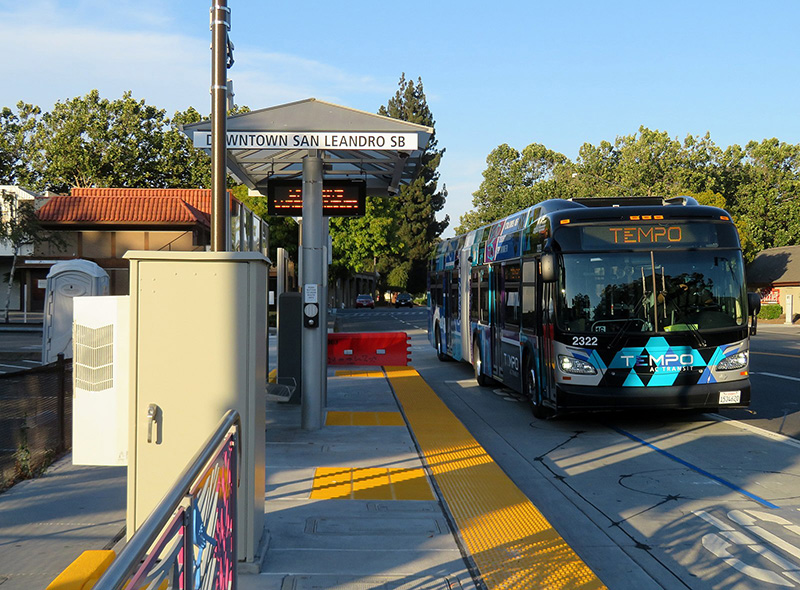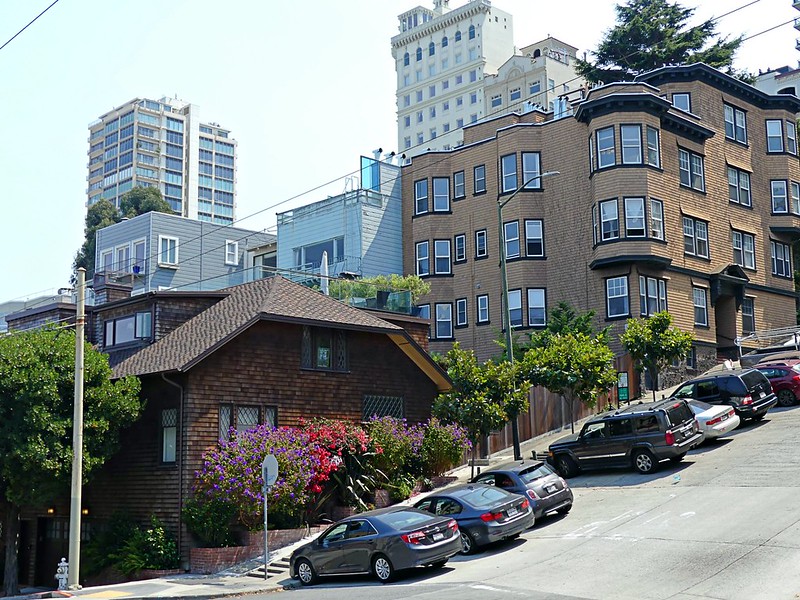Two New California Laws Aim to Boost Housing Supply
| . Posted in News - 0 Comments
By Eric Weld, MassLandlords, Inc.
With the addition of two new California housing laws signed by Gov. Gavin Newsom on Sept. 16, 2021, the West Coast state added to its growing arsenal of legislation aimed at increasing its housing supply and alleviating its persistent housing crisis.

With the ratification of California SB 10, transit-rich areas, such as neighborhoods within half a mile of this bus station near downtown San Leandro, can rezone for denser housing.
In adding the two new laws, California joins its northern neighbor, Oregon, as among the most aggressive U.S. states in combating inefficiencies and inequities in the development of new and affordable housing. Recent laws in both states also continue an emerging nationwide trend of weakening or reducing single-family zoning and the exclusionary and inadequate housing circumstances that result from that outdated land-use policy.
While overt racist practices such as “redlining” and the “Green Book” have faded, single-family zoning is an unfortunate holdover. Few dispute the fact that single-family zoning in the U.S., begun in the 1920s and 30s, was rooted in socio-economic exclusion and racism. This land-use policy is largely responsible for leading the United States to our current national housing crisis by driving up home prices and crowding out available land for building affordable options. Read a detailed history of zoning in the U.S.
Massachusetts is struggling with its own housing shortage, as are several states. So far, however, the Bay State, while it has taken measures to make it easier for municipalities to pass zoning changes, has not acted with nearly the aggression of California and Oregon in promoting new and affordable housing. Intransigence in changing local zoning laws remains widespread across the state.

With the assistance of recent housing laws passed in California, mixed-use neighborhoods like this may become more prevalent. Image: cc by-mksfca-flickr
Cities and Towns Not on Board
California’s latest housing laws, Senate Bills 9 and 10, entered the state’s legislation amid controversy, most prominently opposed by the League of California Cities, a coalition of more than 200 communities in the state. A mid-summer poll also showed a majority of participants opposed to both laws. Opposition primarily charges that SB 9 oversteps state government jurisdiction and usurps cities’ rights to control of property and housing within their borders.
SB 9, Ch. 162 allows owners of single-family zoned properties to split their parcels in two for the purpose of building new housing. The bill also allows the building of an extra housing unit, such as an accessory dwelling unit (ADU) or duplex, on land that is zoned single-family. Taken together, these two clauses could potentially allow up to four units to exist on one single-family zoned property.
SB 10, Ch. 163 aims to allow more density in urban areas near public transit by granting local governments processes for overriding municipal zoning laws and rezoning for up to 10 housing units.
Both bills take effect on Jan. 1, 2022. We take a closer look at them below.
Senate Bill 9
SB 9, dubbed the California HOME (Housing Opportunity & More Efficiency) Act, was introduced by state Sen. Toni Atkins. Part of its intent is to invite home and property owners to join the state’s efforts in developing new and affordable housing by allowing them to: 1) subdivide their parcels in two for the purpose of building extra dwellings; and 2) build an additional dwelling, such as an accessory dwelling unit or duplex, on a lot zoned single-family.
The bill aims to streamline approval processes for new housing proposals that fit the criteria by requiring California cities to ministerially approve qualified building projects and lot subdivisions – that is, to approve such proposals as of right, without discretionary review or public hearing.
Under the law, communities are only allowed to require up to one additional off-street parking space per dwelling unit.
The bill provides safeguards that require any new housing to protect existing tenants, preserve historic neighborhoods and retain local control. The law does not allow demolition or alteration of existing affordable housing, nor the demolition of more than 25% of an existing structure’s exterior walls.
Senate Bill 10
Nicknamed the Local Control for Increased Housing Density law, SB 10 was introduced by state Sen. Scott Wiener. The bill offers a statewide option for municipalities to rezone, or “upzone,” neighborhoods in transit-rich and/or urban infill areas, to allow increased density of up to 10 homes per parcel.
Upzoning is a term that refers to the practice of rezoning land for mixed use, higher density or both. Urban infill describes new development on vacant land sitting amid developed areas.
A transit-rich area is land located within half a mile of public transit, meaning either along a “high-quality bus corridor,” or as defined in the California Public Resources Code, containing either a) a rail or bus rapid transit station, b) a ferry terminal served by bus or rail, or c) an intersection of two or more major bus routes, with service frequency of 15 minutes or less during peak commute hours.
SB 10 purports to provide a solution to the local processes of approving common-sense rezoning proposals that too frequently become mired for years or decades amid legal appeals and litigation.
The bill authorizes municipal governments to rezone neighborhoods at their discretion by passing a resolution to adopt a plan for a higher density of up to 10 dwellings per parcel. The neighborhoods must be in qualifying areas, either urban infill or near a transit-rich area. Qualified rezonings that are approved by local governments under SB 10 will be exempted from being considered a project under the California Environmental Quality Act, a Reagan-era law intended to avoid or reduce environmental damage. Local governments that pass such a resolution can choose whether individual building projects in the newly zoned area will be subject to discretionary approval or granted by right.
SB 10 is supported by California YIMBY (“Yes In My Back Yard”), a statewide community advocacy nonprofit that advocates for affordable housing and other measures to curb the housing shortage, among other groups.
More New Housing Needed
California’s two latest housing laws are part of Building Opportunities for All, an overarching series of bills intended to close the gap between the state’s outsized need for new housing and the current pace of construction.
According to the state’s Department of Housing and Community Development, California will require an estimated 1.8 million new homes (p. 5) by 2025 to meet demand. Some estimates project even higher need: up to 2.5 million new homes necessary to provide enough dwellings for the population needing places to live.
Meanwhile, fewer than 80,000 new homes (p. 6) per year are being built in the state. The median price for California single-family homes is $811,170 in 2021, an increase of 21.7% year over year.
“California is facing a severe housing crisis,” acknowledges the introductory narrative of the Building Opportunities for All initiative, “and Californians need real housing solutions.”
The legislative package is a series of 11 bills, including SBs 9 and 10, centered on expanding housing through measures such as: appropriating funds for affordable rental housing; authorizing development of residential housing on commercially and retail-zoned properties; enabling increases in housing density to allow building of more affordable housing; promoting flexibility in joint occupancy agreements around community college districts; expediting housing projects that satisfy local zoning and land use ordinances; enhancing housing data collection to ascertain progress; and adding administrative government support for assisting communities in planning and developing affordable housing.
“Individually, these bills each address a variety of causes that have contributed to the lack of housing production in our state,” reads the initiative. “Together, they make up a unified approach to this challenge, creating pathways to home ownership, stable housing for vulnerable families, and a way forward to economic stability for Californians across the Golden State.”
Laws Signed Amid Opposition
Offsetting the support of the state government and affordable housing advocacy groups for the two new bills is a groundswell of opposition among local governments and, according to one poll, a majority of California residents.
In addition to the League of California Cities’ charge that the laws preempt local control, other groups, including United Neighbors and Californians for Community Planning, fear the new laws will promote gentrification and erode the character of communities across the state. The latter group is working to gather signatures for a referendum among California voters.
In fact, SB 10 began as SB 50, a similar bill that would have mandated cities to approve rezoning proposals for qualified housing projects. After SB 50 failed to advance out of the state senate in 2020, Sen. Weiner amended it into a voluntary rules package subject to elected approval among local governmental bodies.
Leading up to the passage of SBs 9 and 10, as Gov. Newsom fought to remain in office against a recall effort, a poll was conducted in late July by Housing is a Human Right, the housing advocacy division of the Aids Healthcare Foundation. The poll showed 63% of Californians opposed to SB 9 and 67% opposed to SB 10. Those numbers rose to 71% opposed to SB 9 and 75% opposed to SB 10 after messages and endorsers were shared with poll participants. Most citizens’ objections were based on the fear that the bills will have a negative impact on homeowners and property values, as well as the lack of requirements for affordable housing and provisions for the homeless in the new laws.
California YIMBY, which supports these and other bills in the Building Opportunities for All housing package, counters that local housing control has led the state into a quagmire of housing shortages and unaffordable options. “Local control has led us to an outcome that has actually harmed affordability in California and it’s harmed our families because they’re paying higher portions of their income in rent,” said Gary Painter, chair of the Department of Public Policy at the University of Southern California, in USC Annenberg Media.
From West to East
With the ratification of SBs 9 and 10, combined with other related recent laws, California becomes among the most aggressive U.S. states in combating a seemingly intractable housing shortage that persists in many states with large, urban populations, including Massachusetts.
In late 2019, the state of Oregon passed a law disallowing cities with populations of more than 10,000 people from preventing duplex and townhouse construction on single-family zoned land. The state of Washington is considering similar legislation.
The city of Portland, Ore., went further in promoting denser housing and all but eradicating single-family zoning citywide. The city allows duplexes, triplexes and fourplexes, as well as ADUs and cottages in neighborhoods zoned single-family. New multi-unit projects are not required to provide off-street parking.
Portland is also taking the bold step of limiting the size of new homes being built to replace existing homes, reducing the old limit of 6,750 square feet to a maximum of 3,500 square feet.
In 2020, the city of Minneapolis, Minn., followed Oregon’s lead and became the first major U.S. city to ban single-family zoning in every neighborhood. The policy, which is part of the city’s Minneapolis 2040 comprehensive plan, bans the prohibition of building duplexes and triplexes on single-family zoned land across the city. Partly driving such change is Minneapolis’ ignominious distinction as the U.S. city with the lowest home ownership rate among Black households.
Washington, D.C., has taken recent steps to allow ADUs in most residential zones, and to expand inclusionary zoning for the purpose of adding affordable housing.
Massachusetts, for its part, has taken small steps, for instance, to ease the process for municipalities to change local zoning ordinances in the hope of adding housing, including affordable housing, and to allow the building of ADUs on some single-family zoned properties.
Waiting and Watching with Legislation Ready
As California and Oregon, and possibly Washington, lead the rest of the nation in reducing and eradicating single-family zoning-related laws that are both outdated and harmful to a sustainable national housing framework, other cities and states are watching.
Legislation sits in various stages of consideration across states and cities seeking to change single-family zoning, increase residential density and add affordable housing. President Joe Biden’s proposed multi-trillion-dollar infrastructure plan currently plodding through Congress addresses the issue on a national level, calling for smaller home lots, mixed-use neighborhoods and other affordable housing measures.
Strong pockets of resistance and NIMBY continue to challenge the new laws in California and elsewhere, and misinformation pollutes debates around the best solutions to housing crises. For example, many continue to believe that denser, multi-family housing in single-family neighborhoods drives down property values. However, limited research on the effects of density on property values shows that single-family properties increase in value with higher neighborhood density.
With higher density development comes increased services, more retail options and more efficient infrastructure. These are all factors contributing to enhanced single-family property values for homeowners in such neighborhoods.
But it’s proving difficult in the U.S. to break through entrenched attitudes about single-family properties and realize long-term benefits of denser housing layouts. And as long as single-family zoning remains the preferred residential land-use for much of the United States, housing crises will continue, and increase around urban center perimeters.
The two new California laws are seeds of change, and may be the start of a national trend to blunt the runaway exclusivity of single-family zoning and introduce incentives for providing housing for everyone regardless of socio-economic status.




